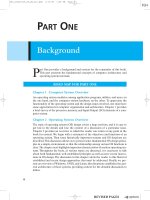Operating system internal and design principles by williams stallings chapter 013
Bạn đang xem bản rút gọn của tài liệu. Xem và tải ngay bản đầy đủ của tài liệu tại đây (215.41 KB, 25 trang )
Networking
Chapter 13
1
Distributed Capabilities
• Communications architectures
– Software that supports a group of networked
computers
• Network operating system
– Each computer has its own private operating
system
• Distributed operating system
– Common operating system shared by a
network of computers
2
The Need for a Protocol
Architecture
• Computer communications
– Exchange of information between
computers for the purpose of cooperative
action
• Computer network
– When tow or more computers are
interconnected via a communication
network
3
Two Concepts
• Protocol
– Used for communication between entities in
different systems
• Protocol architecture
– Broken into subtasks, each of which is
implemented separately
4
File Transfer
5
The TCP/IP Protocol Architecture
• Protocol suite
• Five relatively independent layers
–
–
–
–
–
Physical
Network access
Internet
Host-to-host, or transport
Application
6
Physical Layer
• Specifying
– the characteristics of the transmission
medium
– Nature of the signals
– Data rate
7
Network Access Layer
• Concerned with the exchange of data
between an end system and the network
• Different standards
– Circuit switching
– Packet switching (frame relay)
– LANs (Ethernet)
8
Internet Layer
• Procedures for data to traverse different
networks
• Implemented in the end systems and
routers
9
Transport Layer
• Ensures all data arrives at the destination
and in the order sent
• TCP
10
Application Layer
• Supports various user application
• Example: file transfer
11
TCP Header
12
UDP
13
IP
14
IPv6
• Provides enhancements over existing IP
• Designed to accommodate higher speeds
of a mix of data streams, graphic and
video
• Provides more addresses
• Includes 128-bits for addresses
– IP uses 32-bit address
15
IPv6
16
TCP/IP Concepts
17
Protocols and Headers
18
Items in the Header
• Destination network address
• Facilities requests
– Example: priority
19
TCP.IP Applications
• Simple Mail Transfer Protocol (SMTP)
• File Transfer Protocol
• TELNET
20
Sockets
• Enable communication between a client
and server
• Concatenation of a port value and an IP
address form a socket
21
Two Types of Sockets
• Stream sockets
– Use TCP
– Reliable data transfer
• Datagram sockets
– Use UDP
– Delivery is not guaranteed
22
Socket Setup
• socket() command
• Three parameters
– Protocol family is always PF_INET for
TCP/IP
– Type specifies whether stream or datagram
– Protocol specifies either TCP or UDP
23
24
25









